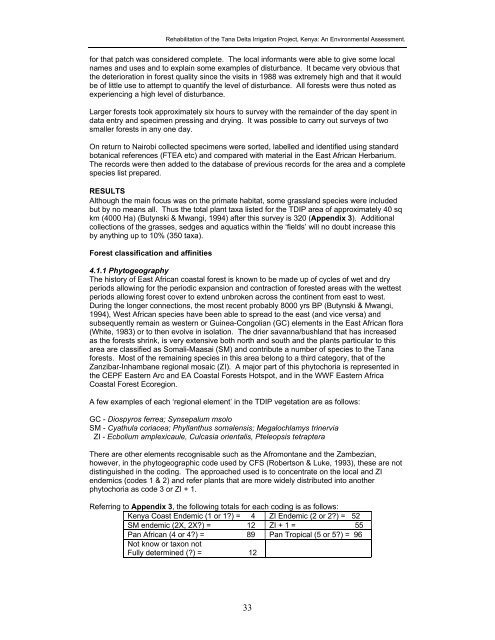Tana Delta Irrigation Project, Kenya: An Environmental Assessment
Tana Delta Irrigation Project, Kenya: An Environmental Assessment
Tana Delta Irrigation Project, Kenya: An Environmental Assessment
Create successful ePaper yourself
Turn your PDF publications into a flip-book with our unique Google optimized e-Paper software.
Rehabilitation of the <strong>Tana</strong> <strong>Delta</strong> <strong>Irrigation</strong> <strong>Project</strong>, <strong>Kenya</strong>: <strong>An</strong> <strong>Environmental</strong> <strong>Assessment</strong>.<br />
for that patch was considered complete. The local informants were able to give some local<br />
names and uses and to explain some examples of disturbance. It became very obvious that<br />
the deterioration in forest quality since the visits in 1988 was extremely high and that it would<br />
be of little use to attempt to quantify the level of disturbance. All forests were thus noted as<br />
experiencing a high level of disturbance.<br />
Larger forests took approximately six hours to survey with the remainder of the day spent in<br />
data entry and specimen pressing and drying. It was possible to carry out surveys of two<br />
smaller forests in any one day.<br />
On return to Nairobi collected specimens were sorted, labelled and identified using standard<br />
botanical references (FTEA etc) and compared with material in the East African Herbarium.<br />
The records were then added to the database of previous records for the area and a complete<br />
species list prepared.<br />
RESULTS<br />
Although the main focus was on the primate habitat, some grassland species were included<br />
but by no means all. Thus the total plant taxa listed for the TDIP area of approximately 40 sq<br />
km (4000 Ha) (Butynski & Mwangi, 1994) after this survey is 320 (Appendix 3). Additional<br />
collections of the grasses, sedges and aquatics within the ‘fields’ will no doubt increase this<br />
by anything up to 10% (350 taxa).<br />
Forest classification and affinities<br />
4.1.1 Phytogeography<br />
The history of East African coastal forest is known to be made up of cycles of wet and dry<br />
periods allowing for the periodic expansion and contraction of forested areas with the wettest<br />
periods allowing forest cover to extend unbroken across the continent from east to west.<br />
During the longer connections, the most recent probably 8000 yrs BP (Butynski & Mwangi,<br />
1994), West African species have been able to spread to the east (and vice versa) and<br />
subsequently remain as western or Guinea-Congolian (GC) elements in the East African flora<br />
(White, 1983) or to then evolve in isolation. The drier savanna/bushland that has increased<br />
as the forests shrink, is very extensive both north and south and the plants particular to this<br />
area are classified as Somali-Maasai (SM) and contribute a number of species to the <strong>Tana</strong><br />
forests. Most of the remaining species in this area belong to a third category, that of the<br />
Zanzibar-Inhambane regional mosaic (ZI). A major part of this phytochoria is represented in<br />
the CEPF Eastern Arc and EA Coastal Forests Hotspot, and in the WWF Eastern Africa<br />
Coastal Forest Ecoregion.<br />
A few examples of each ‘regional element’ in the TDIP vegetation are as follows:<br />
GC - Diospyros ferrea; Synsepalum msolo<br />
SM - Cyathula coriacea; Phyllanthus somalensis; Megalochlamys trinervia<br />
ZI - Ecbolium amplexicaule, Culcasia orientalis, Pteleopsis tetraptera<br />
There are other elements recognisable such as the Afromontane and the Zambezian,<br />
however, in the phytogeographic code used by CFS (Robertson & Luke, 1993), these are not<br />
distinguished in the coding. The approached used is to concentrate on the local and ZI<br />
endemics (codes 1 & 2) and refer plants that are more widely distributed into another<br />
phytochoria as code 3 or ZI + 1.<br />
Referring to Appendix 3, the following totals for each coding is as follows:<br />
<strong>Kenya</strong> Coast Endemic (1 or 1?) = 4 ZI Endemic (2 or 2?) = 52<br />
SM endemic (2X, 2X?) = 12 ZI + 1 = 55<br />
Pan African (4 or 4?) = 89 Pan Tropical (5 or 5?) = 96<br />
Not know or taxon not<br />
Fully determined (?) = 12<br />
33

















